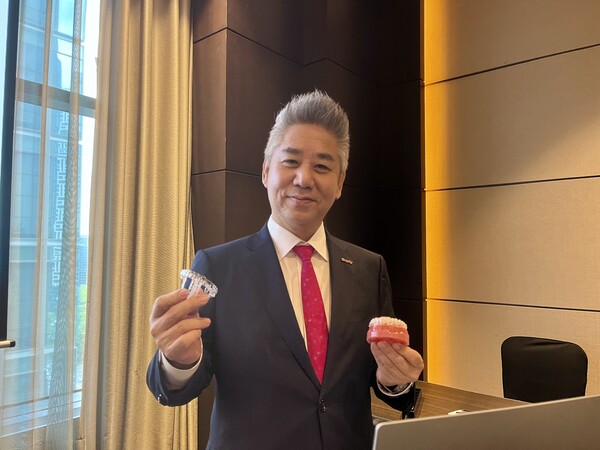
Graphy, a 3D printing materials company based in Korea, believes it has built more than a better aligner. It claims to have built a system that could reshape the multibillion-dollar orthodontics market -- powered by a robot, a printer and a material that remembers your teeth.
The company calls it SMA, or shape-memory aligner: a light-cured resin that softens at oral temperature, wraps snugly around each tooth, and gradually returns to its printed form. Graphy says the material delivers “bracket-level force" without metal or attachments, cutting treatment time in half.
“This isn’t just another plastic tray,” Sim Un-seob, Graphy’s founder and chief executive, said at a press conference in Seoul on Wednesday. “This is orthodontic force. This is shape memory. This is the next bracket.”
With a Kosdaq listing set for Aug. 21, the company is preparing a push into the United States, aiming to raise up to 39 billion won ($28 million) to fund a Florida subsidiary, acquire a dental lab and build out a direct-to-clinic operation.
Graphy says it can offer what Invisalign can’t: faster treatment, cheaper production, and fewer steps, some of them automated. The company stumbled onto the resin in 2017 while prototyping surgical splints. During testing, it bent, recovered and held its shape.
“When we saw that the material could remember and recover complex geometries, we started to imagine what else it could do,” Sim said. “Orthodontics was the obvious next step.”
The result was Tera Harz, a printable resin that activates at mouth temperature. Unlike traditional aligners that require thermoforming -- a process Sim says can introduce distortion -- Graphy prints its trays in final form. That, he said, gives them more accurate fit and sustained force.
The aligners are already in use in 37 countries, sold through local distributors. But in the U.S., Graphy is taking a different approach: installing production hubs inside dental clinics, bypassing the lab model entirely. That strategy has appealed to general dentists often excluded from the aligner business, according to company executives.
“Orthodontists take pride in their hand skills,” said Lee Kwon-ki, Graphy’s director of strategic planning. “But SMA changes the equation. A general dentist can be trained in two days.”

Align Technology, maker of Invisalign, controls about 95 percent of Korea’s aligner market and has long maintained an edge through vertical integration. Graphy says it can match that -- and automate it. The printed aligners, Lee said, retain their grip and shape for weeks, reducing the need for mid-treatment refinements.
To demonstrate, Lee dipped a hardened aligner into warm water. Seconds later, he bent it nearly in half, twisting it like licorice. Then he snapped it back into shape. “This is not plastic,” he said. “This is shape memory. And it returns to its original form every single time.”
Internal and external studies show a 99.6 percent fit rate, according to Lee, with more than half of patients completing treatment without additional trays. That can also reduce costs, Lee said, noting that clinics using SMA spend about $150 to $190 per patient on materials, compared with the roughly $1,200 Korean clinics pay in Invisalign lab fees.
Graphy, which also sells printers, post-processing robots and software, is betting its long-term profits will come not just from trays, but from turning clinics into micro-factories.
“Orthodontics used to belong to specialists,” Lee said. "But with Tera Harz, that’s shifting. You don’t need lab techs or refinements. You just need a printer and two days of training.”
Graphy says its resins have been exported to more than 90 countries and cited in over 60 peer-reviewed journals. Lee says more than 200,000 patients have been treated with some version of the SMA system.
But the company faces a formidable rival. Align Technology holds more than 3,000 patents and a market capitalization of about $15 billion.
“We know brand matters in the U.S.,” Lee said. “But so does disruption. Just like how Tesla wasn’t the first EV, we won’t be the first aligner company in the U.S. But we think we’ll be the first to change how aligners are made.”
Public subscription for Graphy’s IPO is scheduled for Aug. 11 and 12. The company will offer 1.95 million shares. The offering is priced between 17,000 and 20,000 won per share, targeting a valuation between 187.7 billion and 220.6 billion won.
KB Securities and Shinhan Investment are underwriting the offering. Institutional bookbuilding closes Aug. 6.

